Food Insecurity in Malawi's Prisons
VerifiedAdded on 2023/06/11
|15
|3227
|235
AI Summary
This article discusses the issue of food insecurity in Malawi's prisons, including indicators, food consumption, strengths, and limitations in dealing with the issue. The study shows that there is a high level of food inequality among prisoners, with a significant percentage suffering from poverty and hunger. The government of Malawi has made a commitment to achieving the millennium development goals, including improving the health standards of prisoners.
Contribute Materials
Your contribution can guide someone’s learning journey. Share your
documents today.
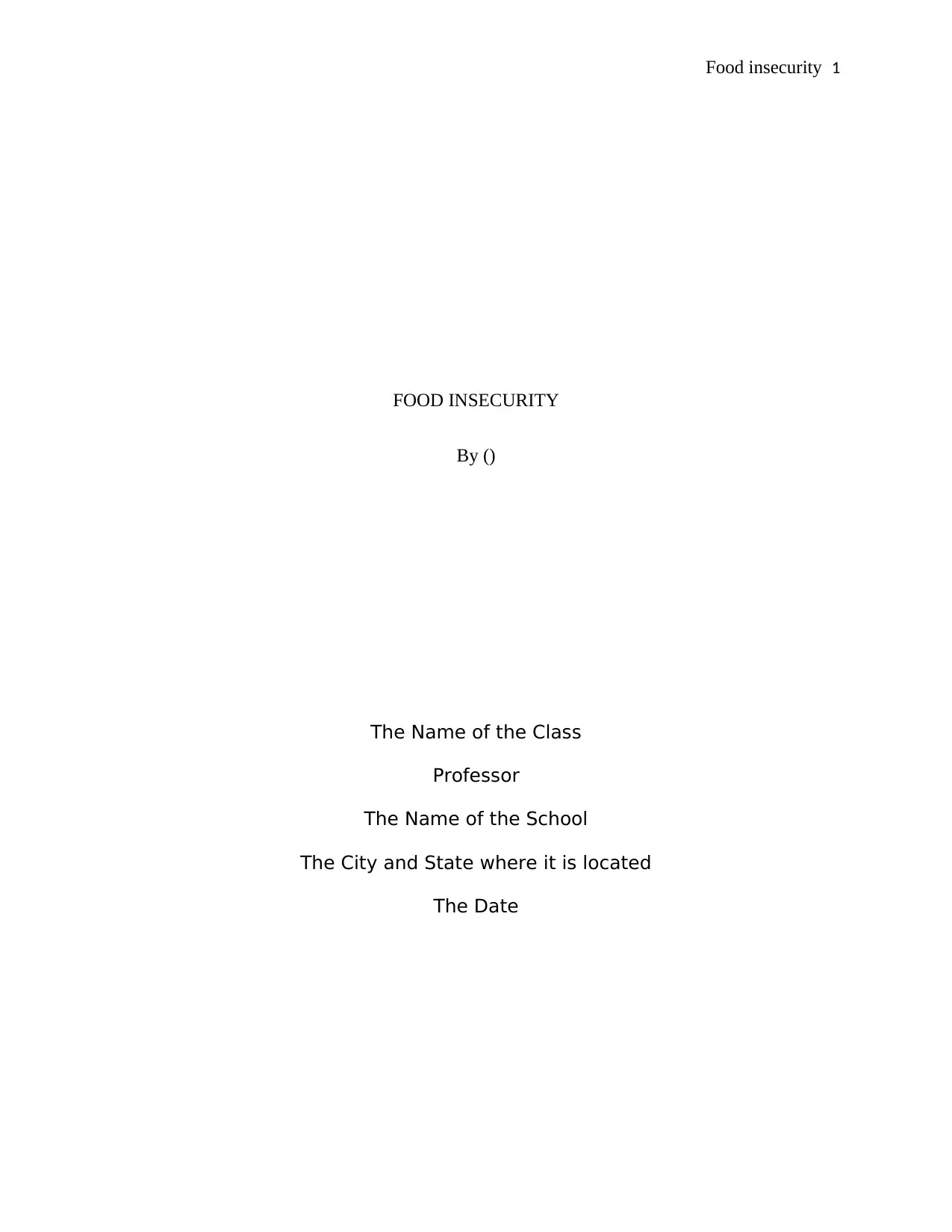
Food insecurity 1
FOOD INSECURITY
By ()
The Name of the Class
Professor
The Name of the School
The City and State where it is located
The Date
FOOD INSECURITY
By ()
The Name of the Class
Professor
The Name of the School
The City and State where it is located
The Date
Secure Best Marks with AI Grader
Need help grading? Try our AI Grader for instant feedback on your assignments.
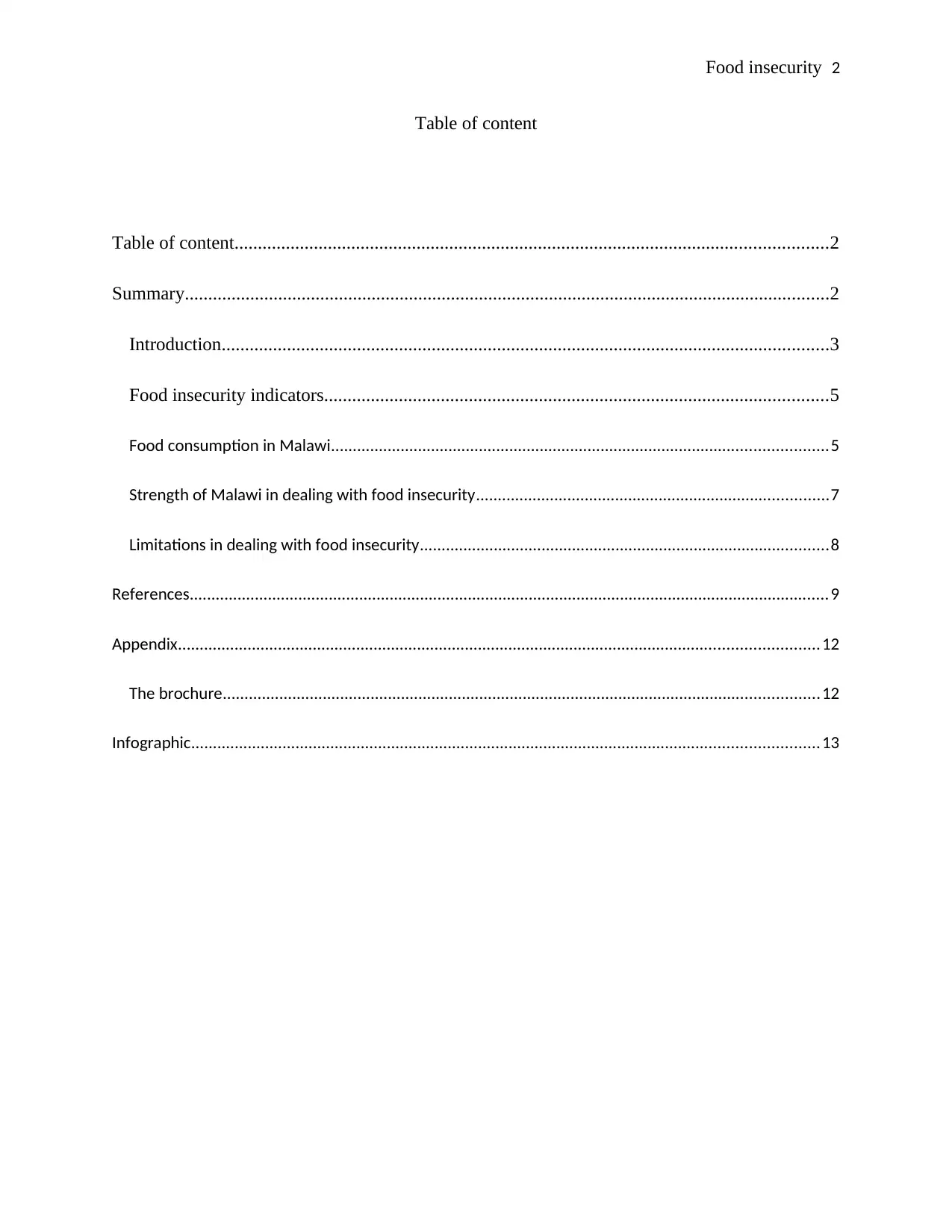
Food insecurity 2
Table of content
Table of content...............................................................................................................................2
Summary..........................................................................................................................................2
Introduction..................................................................................................................................3
Food insecurity indicators............................................................................................................5
Food consumption in Malawi..................................................................................................................5
Strength of Malawi in dealing with food insecurity.................................................................................7
Limitations in dealing with food insecurity..............................................................................................8
References...................................................................................................................................................9
Appendix...................................................................................................................................................12
The brochure.........................................................................................................................................12
Infographic................................................................................................................................................13
Table of content
Table of content...............................................................................................................................2
Summary..........................................................................................................................................2
Introduction..................................................................................................................................3
Food insecurity indicators............................................................................................................5
Food consumption in Malawi..................................................................................................................5
Strength of Malawi in dealing with food insecurity.................................................................................7
Limitations in dealing with food insecurity..............................................................................................8
References...................................................................................................................................................9
Appendix...................................................................................................................................................12
The brochure.........................................................................................................................................12
Infographic................................................................................................................................................13
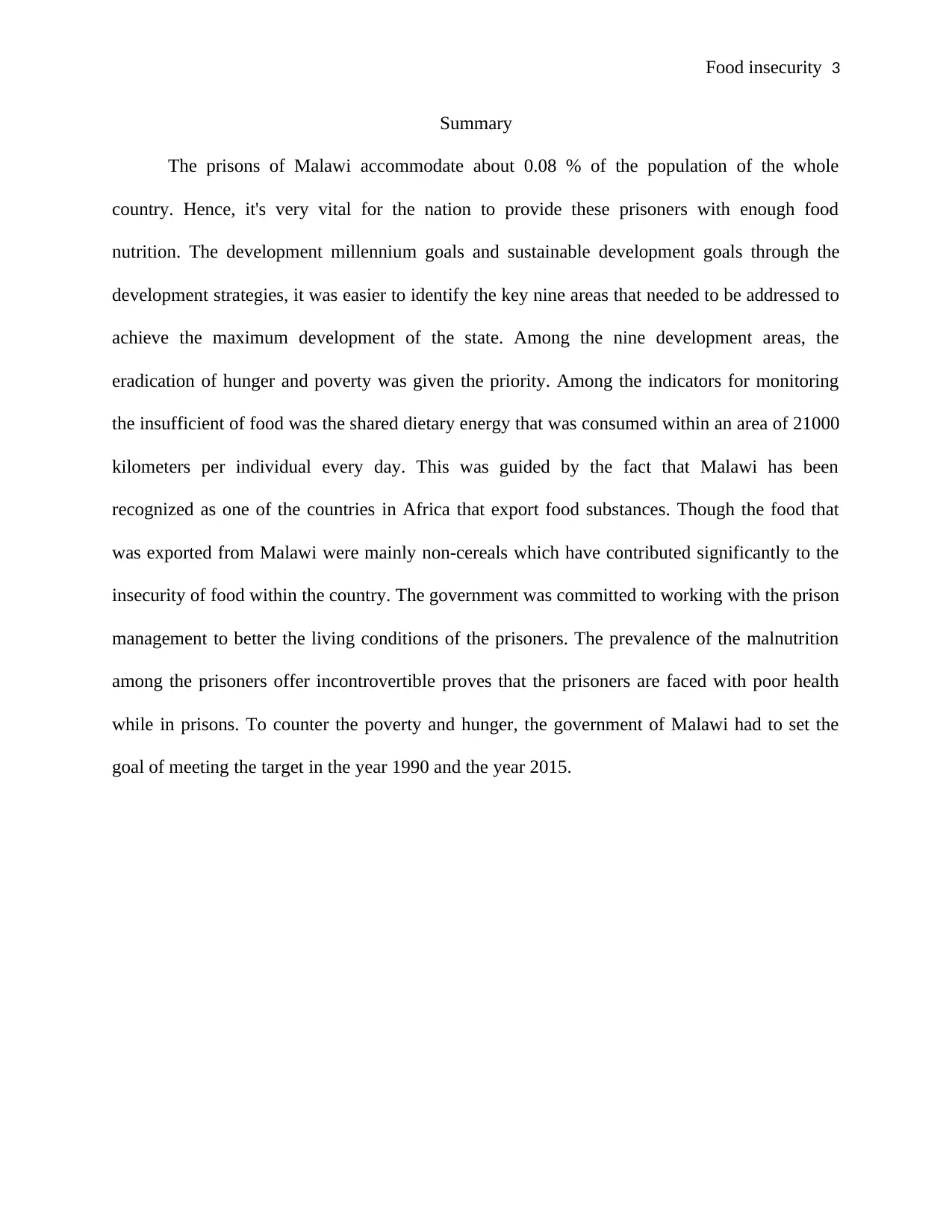
Food insecurity 3
Summary
The prisons of Malawi accommodate about 0.08 % of the population of the whole
country. Hence, it's very vital for the nation to provide these prisoners with enough food
nutrition. The development millennium goals and sustainable development goals through the
development strategies, it was easier to identify the key nine areas that needed to be addressed to
achieve the maximum development of the state. Among the nine development areas, the
eradication of hunger and poverty was given the priority. Among the indicators for monitoring
the insufficient of food was the shared dietary energy that was consumed within an area of 21000
kilometers per individual every day. This was guided by the fact that Malawi has been
recognized as one of the countries in Africa that export food substances. Though the food that
was exported from Malawi were mainly non-cereals which have contributed significantly to the
insecurity of food within the country. The government was committed to working with the prison
management to better the living conditions of the prisoners. The prevalence of the malnutrition
among the prisoners offer incontrovertible proves that the prisoners are faced with poor health
while in prisons. To counter the poverty and hunger, the government of Malawi had to set the
goal of meeting the target in the year 1990 and the year 2015.
Summary
The prisons of Malawi accommodate about 0.08 % of the population of the whole
country. Hence, it's very vital for the nation to provide these prisoners with enough food
nutrition. The development millennium goals and sustainable development goals through the
development strategies, it was easier to identify the key nine areas that needed to be addressed to
achieve the maximum development of the state. Among the nine development areas, the
eradication of hunger and poverty was given the priority. Among the indicators for monitoring
the insufficient of food was the shared dietary energy that was consumed within an area of 21000
kilometers per individual every day. This was guided by the fact that Malawi has been
recognized as one of the countries in Africa that export food substances. Though the food that
was exported from Malawi were mainly non-cereals which have contributed significantly to the
insecurity of food within the country. The government was committed to working with the prison
management to better the living conditions of the prisoners. The prevalence of the malnutrition
among the prisoners offer incontrovertible proves that the prisoners are faced with poor health
while in prisons. To counter the poverty and hunger, the government of Malawi had to set the
goal of meeting the target in the year 1990 and the year 2015.
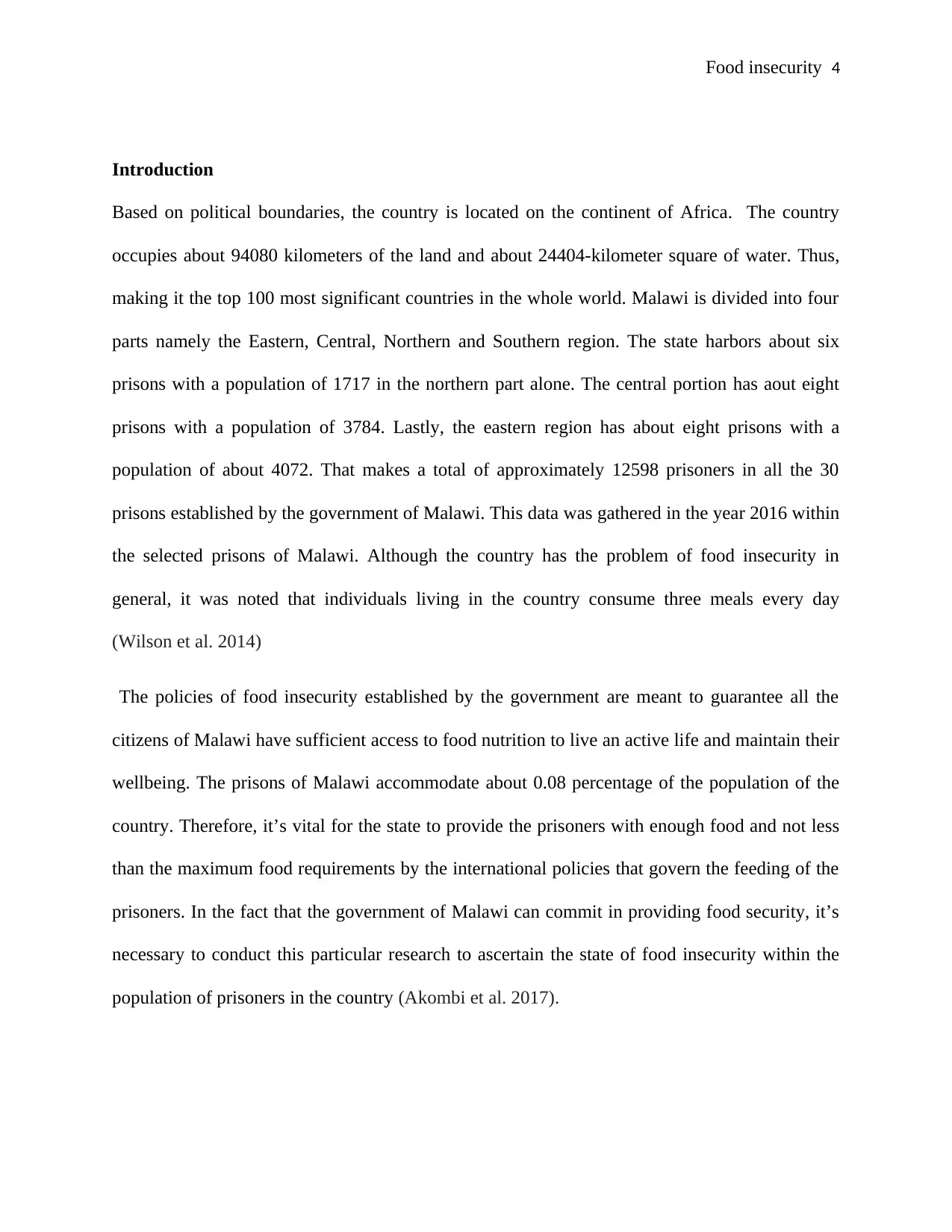
Food insecurity 4
Introduction
Based on political boundaries, the country is located on the continent of Africa. The country
occupies about 94080 kilometers of the land and about 24404-kilometer square of water. Thus,
making it the top 100 most significant countries in the whole world. Malawi is divided into four
parts namely the Eastern, Central, Northern and Southern region. The state harbors about six
prisons with a population of 1717 in the northern part alone. The central portion has aout eight
prisons with a population of 3784. Lastly, the eastern region has about eight prisons with a
population of about 4072. That makes a total of approximately 12598 prisoners in all the 30
prisons established by the government of Malawi. This data was gathered in the year 2016 within
the selected prisons of Malawi. Although the country has the problem of food insecurity in
general, it was noted that individuals living in the country consume three meals every day
(Wilson et al. 2014)
The policies of food insecurity established by the government are meant to guarantee all the
citizens of Malawi have sufficient access to food nutrition to live an active life and maintain their
wellbeing. The prisons of Malawi accommodate about 0.08 percentage of the population of the
country. Therefore, it’s vital for the state to provide the prisoners with enough food and not less
than the maximum food requirements by the international policies that govern the feeding of the
prisoners. In the fact that the government of Malawi can commit in providing food security, it’s
necessary to conduct this particular research to ascertain the state of food insecurity within the
population of prisoners in the country (Akombi et al. 2017).
Introduction
Based on political boundaries, the country is located on the continent of Africa. The country
occupies about 94080 kilometers of the land and about 24404-kilometer square of water. Thus,
making it the top 100 most significant countries in the whole world. Malawi is divided into four
parts namely the Eastern, Central, Northern and Southern region. The state harbors about six
prisons with a population of 1717 in the northern part alone. The central portion has aout eight
prisons with a population of 3784. Lastly, the eastern region has about eight prisons with a
population of about 4072. That makes a total of approximately 12598 prisoners in all the 30
prisons established by the government of Malawi. This data was gathered in the year 2016 within
the selected prisons of Malawi. Although the country has the problem of food insecurity in
general, it was noted that individuals living in the country consume three meals every day
(Wilson et al. 2014)
The policies of food insecurity established by the government are meant to guarantee all the
citizens of Malawi have sufficient access to food nutrition to live an active life and maintain their
wellbeing. The prisons of Malawi accommodate about 0.08 percentage of the population of the
country. Therefore, it’s vital for the state to provide the prisoners with enough food and not less
than the maximum food requirements by the international policies that govern the feeding of the
prisoners. In the fact that the government of Malawi can commit in providing food security, it’s
necessary to conduct this particular research to ascertain the state of food insecurity within the
population of prisoners in the country (Akombi et al. 2017).
Secure Best Marks with AI Grader
Need help grading? Try our AI Grader for instant feedback on your assignments.
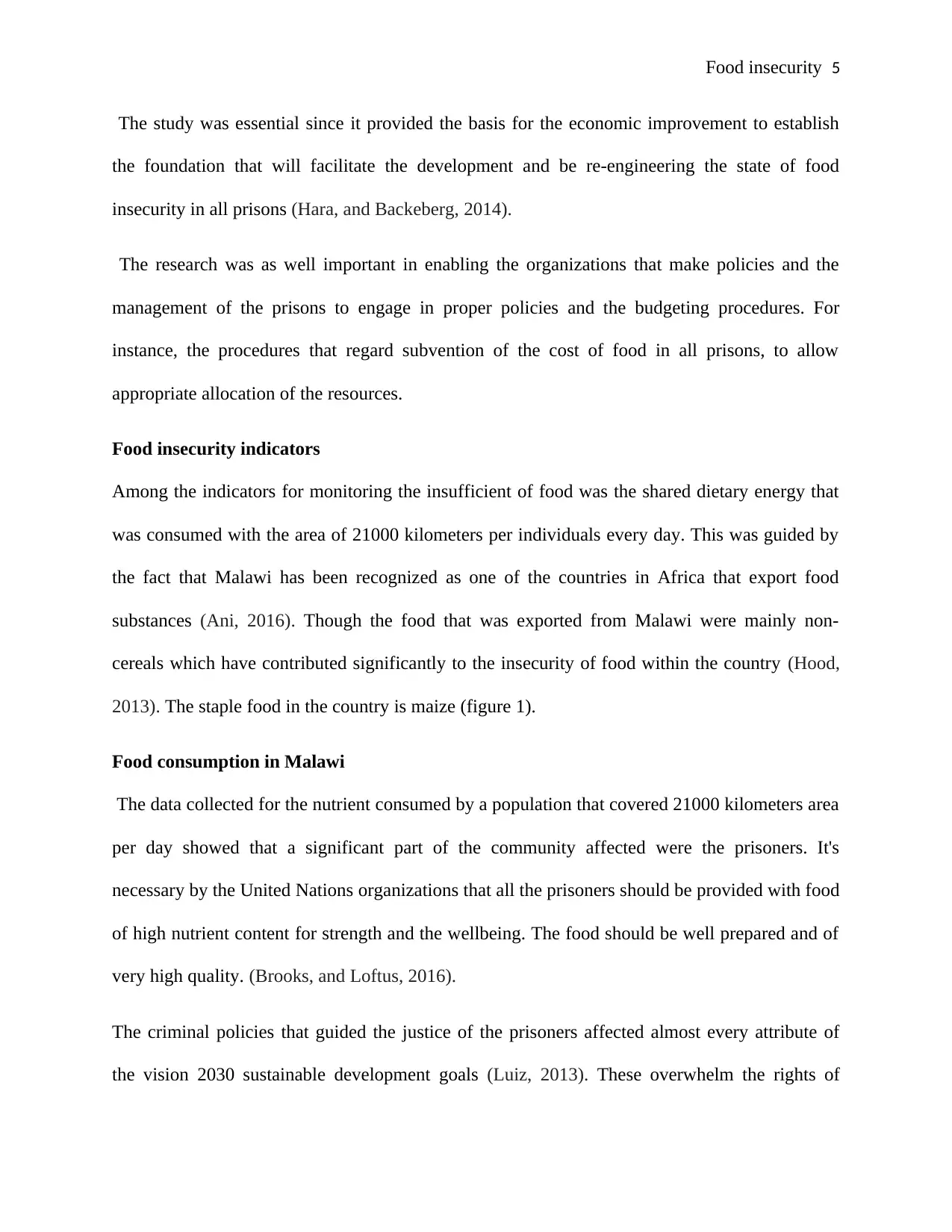
Food insecurity 5
The study was essential since it provided the basis for the economic improvement to establish
the foundation that will facilitate the development and be re-engineering the state of food
insecurity in all prisons (Hara, and Backeberg, 2014).
The research was as well important in enabling the organizations that make policies and the
management of the prisons to engage in proper policies and the budgeting procedures. For
instance, the procedures that regard subvention of the cost of food in all prisons, to allow
appropriate allocation of the resources.
Food insecurity indicators
Among the indicators for monitoring the insufficient of food was the shared dietary energy that
was consumed with the area of 21000 kilometers per individuals every day. This was guided by
the fact that Malawi has been recognized as one of the countries in Africa that export food
substances (Ani, 2016). Though the food that was exported from Malawi were mainly non-
cereals which have contributed significantly to the insecurity of food within the country (Hood,
2013). The staple food in the country is maize (figure 1).
Food consumption in Malawi
The data collected for the nutrient consumed by a population that covered 21000 kilometers area
per day showed that a significant part of the community affected were the prisoners. It's
necessary by the United Nations organizations that all the prisoners should be provided with food
of high nutrient content for strength and the wellbeing. The food should be well prepared and of
very high quality. (Brooks, and Loftus, 2016).
The criminal policies that guided the justice of the prisoners affected almost every attribute of
the vision 2030 sustainable development goals (Luiz, 2013). These overwhelm the rights of
The study was essential since it provided the basis for the economic improvement to establish
the foundation that will facilitate the development and be re-engineering the state of food
insecurity in all prisons (Hara, and Backeberg, 2014).
The research was as well important in enabling the organizations that make policies and the
management of the prisons to engage in proper policies and the budgeting procedures. For
instance, the procedures that regard subvention of the cost of food in all prisons, to allow
appropriate allocation of the resources.
Food insecurity indicators
Among the indicators for monitoring the insufficient of food was the shared dietary energy that
was consumed with the area of 21000 kilometers per individuals every day. This was guided by
the fact that Malawi has been recognized as one of the countries in Africa that export food
substances (Ani, 2016). Though the food that was exported from Malawi were mainly non-
cereals which have contributed significantly to the insecurity of food within the country (Hood,
2013). The staple food in the country is maize (figure 1).
Food consumption in Malawi
The data collected for the nutrient consumed by a population that covered 21000 kilometers area
per day showed that a significant part of the community affected were the prisoners. It's
necessary by the United Nations organizations that all the prisoners should be provided with food
of high nutrient content for strength and the wellbeing. The food should be well prepared and of
very high quality. (Brooks, and Loftus, 2016).
The criminal policies that guided the justice of the prisoners affected almost every attribute of
the vision 2030 sustainable development goals (Luiz, 2013). These overwhelm the rights of
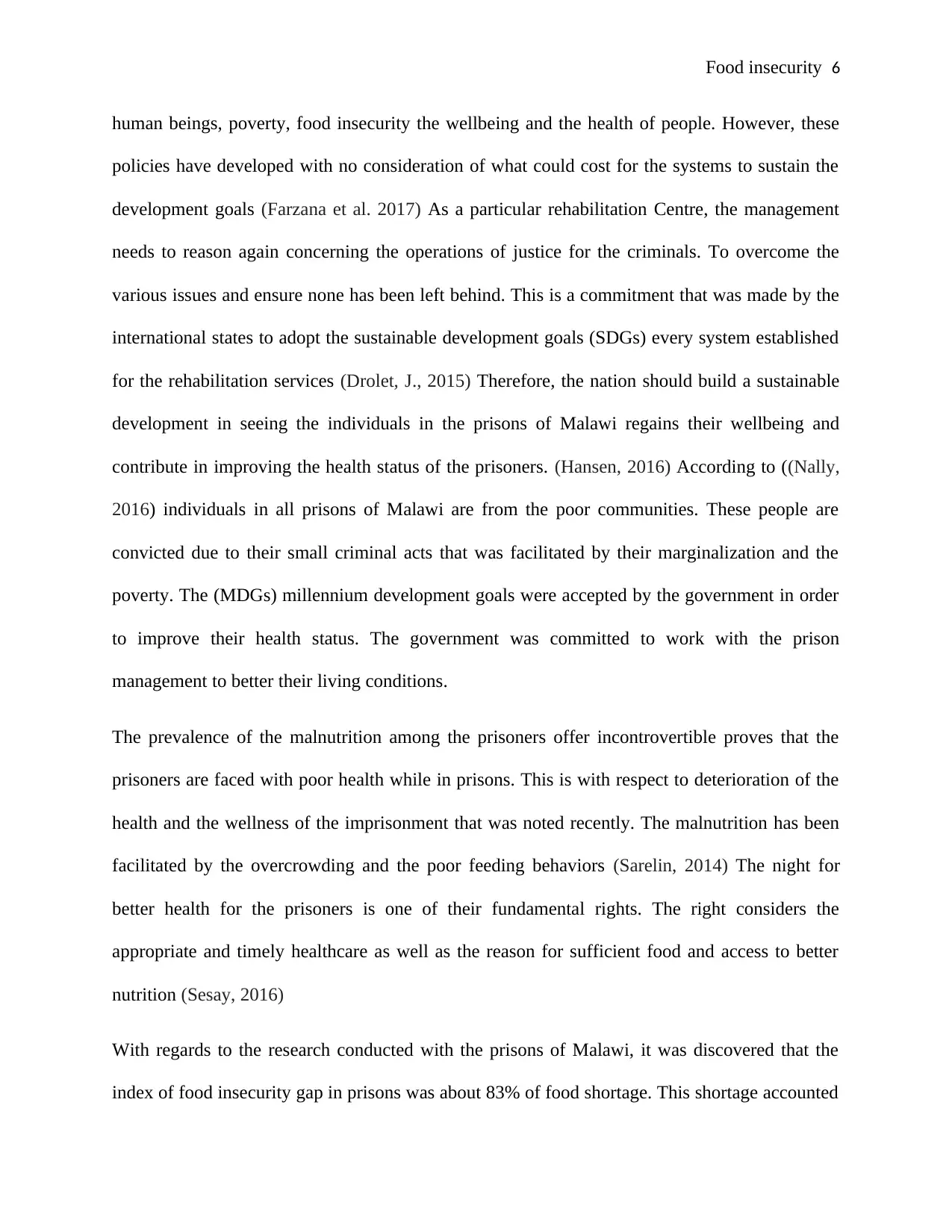
Food insecurity 6
human beings, poverty, food insecurity the wellbeing and the health of people. However, these
policies have developed with no consideration of what could cost for the systems to sustain the
development goals (Farzana et al. 2017) As a particular rehabilitation Centre, the management
needs to reason again concerning the operations of justice for the criminals. To overcome the
various issues and ensure none has been left behind. This is a commitment that was made by the
international states to adopt the sustainable development goals (SDGs) every system established
for the rehabilitation services (Drolet, J., 2015) Therefore, the nation should build a sustainable
development in seeing the individuals in the prisons of Malawi regains their wellbeing and
contribute in improving the health status of the prisoners. (Hansen, 2016) According to ((Nally,
2016) individuals in all prisons of Malawi are from the poor communities. These people are
convicted due to their small criminal acts that was facilitated by their marginalization and the
poverty. The (MDGs) millennium development goals were accepted by the government in order
to improve their health status. The government was committed to work with the prison
management to better their living conditions.
The prevalence of the malnutrition among the prisoners offer incontrovertible proves that the
prisoners are faced with poor health while in prisons. This is with respect to deterioration of the
health and the wellness of the imprisonment that was noted recently. The malnutrition has been
facilitated by the overcrowding and the poor feeding behaviors (Sarelin, 2014) The night for
better health for the prisoners is one of their fundamental rights. The right considers the
appropriate and timely healthcare as well as the reason for sufficient food and access to better
nutrition (Sesay, 2016)
With regards to the research conducted with the prisons of Malawi, it was discovered that the
index of food insecurity gap in prisons was about 83% of food shortage. This shortage accounted
human beings, poverty, food insecurity the wellbeing and the health of people. However, these
policies have developed with no consideration of what could cost for the systems to sustain the
development goals (Farzana et al. 2017) As a particular rehabilitation Centre, the management
needs to reason again concerning the operations of justice for the criminals. To overcome the
various issues and ensure none has been left behind. This is a commitment that was made by the
international states to adopt the sustainable development goals (SDGs) every system established
for the rehabilitation services (Drolet, J., 2015) Therefore, the nation should build a sustainable
development in seeing the individuals in the prisons of Malawi regains their wellbeing and
contribute in improving the health status of the prisoners. (Hansen, 2016) According to ((Nally,
2016) individuals in all prisons of Malawi are from the poor communities. These people are
convicted due to their small criminal acts that was facilitated by their marginalization and the
poverty. The (MDGs) millennium development goals were accepted by the government in order
to improve their health status. The government was committed to work with the prison
management to better their living conditions.
The prevalence of the malnutrition among the prisoners offer incontrovertible proves that the
prisoners are faced with poor health while in prisons. This is with respect to deterioration of the
health and the wellness of the imprisonment that was noted recently. The malnutrition has been
facilitated by the overcrowding and the poor feeding behaviors (Sarelin, 2014) The night for
better health for the prisoners is one of their fundamental rights. The right considers the
appropriate and timely healthcare as well as the reason for sufficient food and access to better
nutrition (Sesay, 2016)
With regards to the research conducted with the prisons of Malawi, it was discovered that the
index of food insecurity gap in prisons was about 83% of food shortage. This shortage accounted
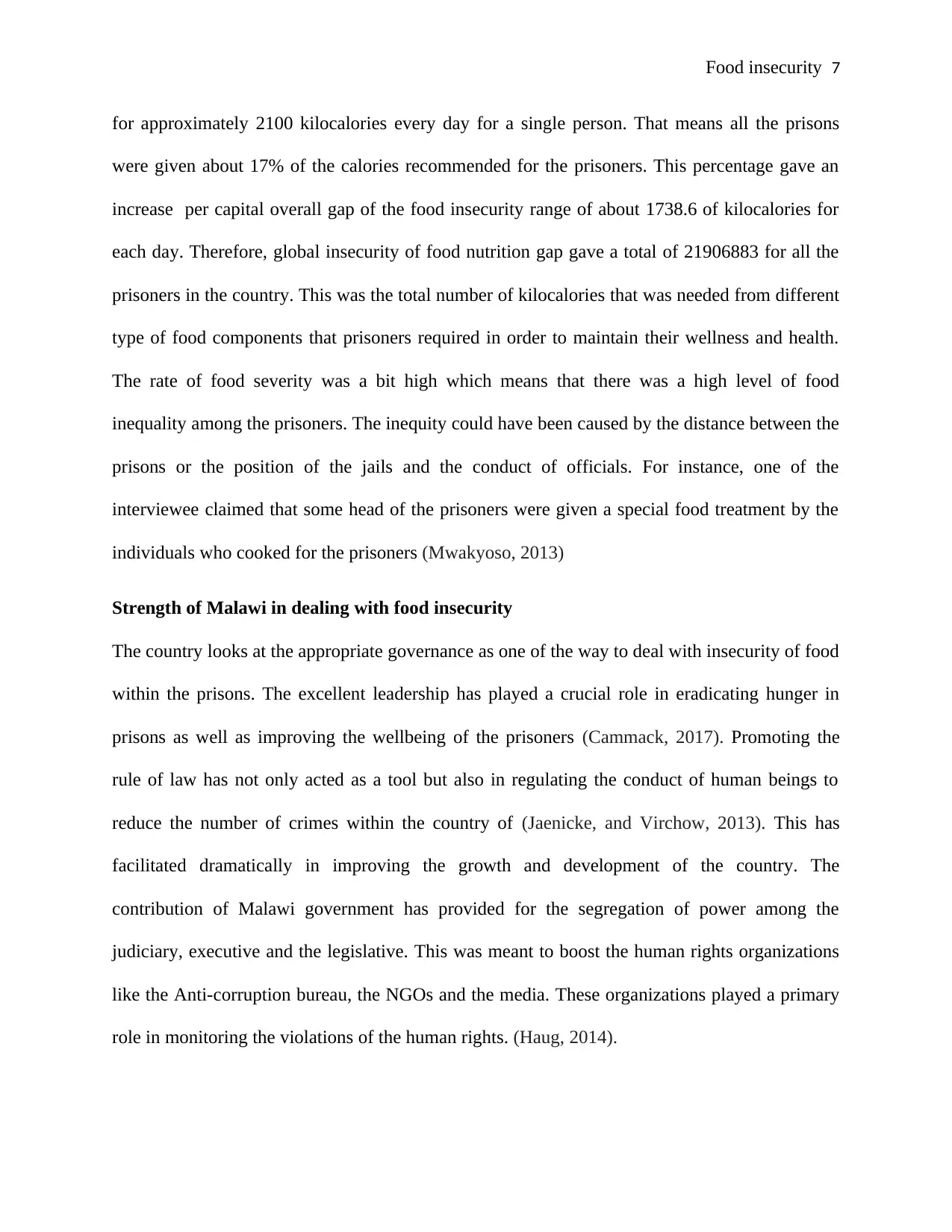
Food insecurity 7
for approximately 2100 kilocalories every day for a single person. That means all the prisons
were given about 17% of the calories recommended for the prisoners. This percentage gave an
increase per capital overall gap of the food insecurity range of about 1738.6 of kilocalories for
each day. Therefore, global insecurity of food nutrition gap gave a total of 21906883 for all the
prisoners in the country. This was the total number of kilocalories that was needed from different
type of food components that prisoners required in order to maintain their wellness and health.
The rate of food severity was a bit high which means that there was a high level of food
inequality among the prisoners. The inequity could have been caused by the distance between the
prisons or the position of the jails and the conduct of officials. For instance, one of the
interviewee claimed that some head of the prisoners were given a special food treatment by the
individuals who cooked for the prisoners (Mwakyoso, 2013)
Strength of Malawi in dealing with food insecurity
The country looks at the appropriate governance as one of the way to deal with insecurity of food
within the prisons. The excellent leadership has played a crucial role in eradicating hunger in
prisons as well as improving the wellbeing of the prisoners (Cammack, 2017). Promoting the
rule of law has not only acted as a tool but also in regulating the conduct of human beings to
reduce the number of crimes within the country of (Jaenicke, and Virchow, 2013). This has
facilitated dramatically in improving the growth and development of the country. The
contribution of Malawi government has provided for the segregation of power among the
judiciary, executive and the legislative. This was meant to boost the human rights organizations
like the Anti-corruption bureau, the NGOs and the media. These organizations played a primary
role in monitoring the violations of the human rights. (Haug, 2014).
for approximately 2100 kilocalories every day for a single person. That means all the prisons
were given about 17% of the calories recommended for the prisoners. This percentage gave an
increase per capital overall gap of the food insecurity range of about 1738.6 of kilocalories for
each day. Therefore, global insecurity of food nutrition gap gave a total of 21906883 for all the
prisoners in the country. This was the total number of kilocalories that was needed from different
type of food components that prisoners required in order to maintain their wellness and health.
The rate of food severity was a bit high which means that there was a high level of food
inequality among the prisoners. The inequity could have been caused by the distance between the
prisons or the position of the jails and the conduct of officials. For instance, one of the
interviewee claimed that some head of the prisoners were given a special food treatment by the
individuals who cooked for the prisoners (Mwakyoso, 2013)
Strength of Malawi in dealing with food insecurity
The country looks at the appropriate governance as one of the way to deal with insecurity of food
within the prisons. The excellent leadership has played a crucial role in eradicating hunger in
prisons as well as improving the wellbeing of the prisoners (Cammack, 2017). Promoting the
rule of law has not only acted as a tool but also in regulating the conduct of human beings to
reduce the number of crimes within the country of (Jaenicke, and Virchow, 2013). This has
facilitated dramatically in improving the growth and development of the country. The
contribution of Malawi government has provided for the segregation of power among the
judiciary, executive and the legislative. This was meant to boost the human rights organizations
like the Anti-corruption bureau, the NGOs and the media. These organizations played a primary
role in monitoring the violations of the human rights. (Haug, 2014).
Paraphrase This Document
Need a fresh take? Get an instant paraphrase of this document with our AI Paraphraser
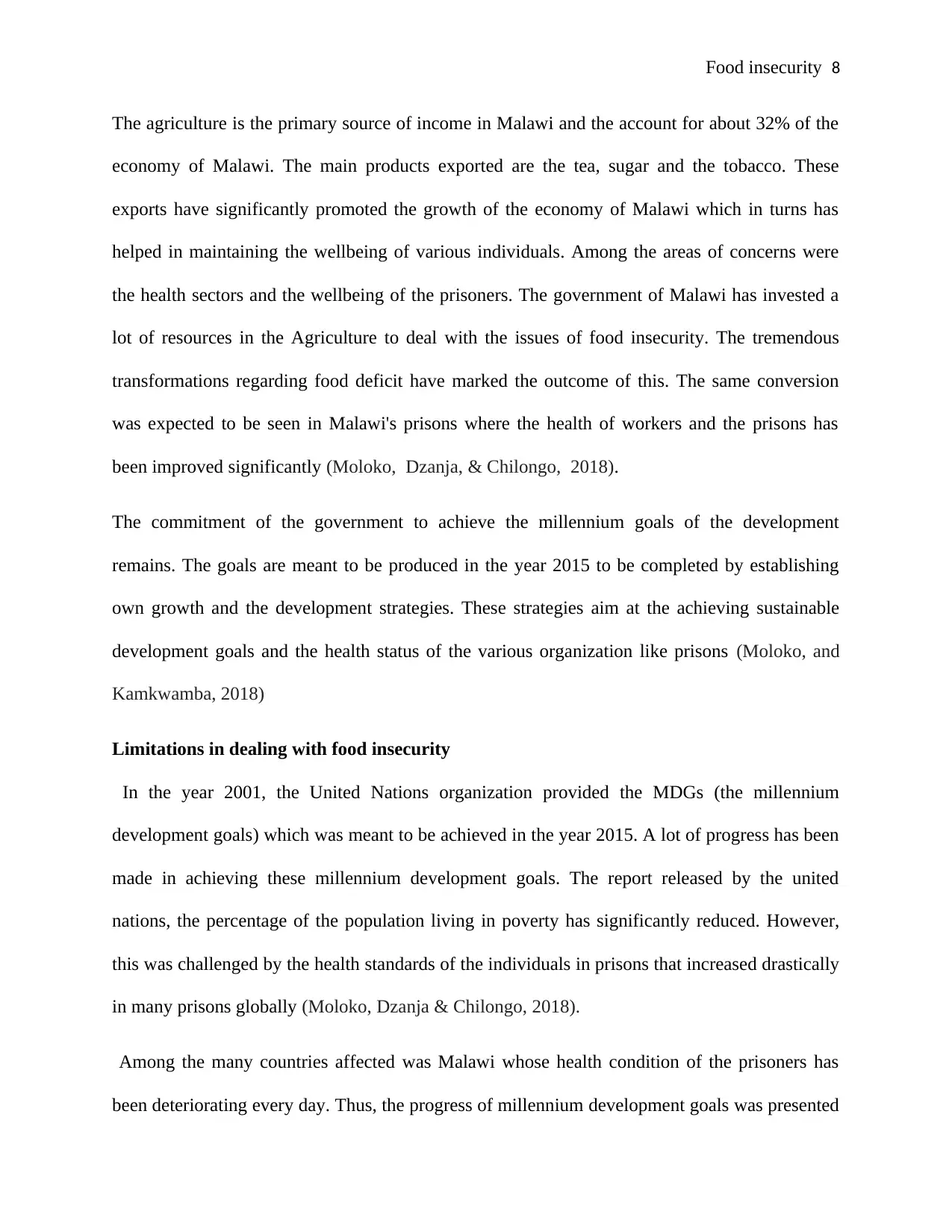
Food insecurity 8
The agriculture is the primary source of income in Malawi and the account for about 32% of the
economy of Malawi. The main products exported are the tea, sugar and the tobacco. These
exports have significantly promoted the growth of the economy of Malawi which in turns has
helped in maintaining the wellbeing of various individuals. Among the areas of concerns were
the health sectors and the wellbeing of the prisoners. The government of Malawi has invested a
lot of resources in the Agriculture to deal with the issues of food insecurity. The tremendous
transformations regarding food deficit have marked the outcome of this. The same conversion
was expected to be seen in Malawi's prisons where the health of workers and the prisons has
been improved significantly (Moloko, Dzanja, & Chilongo, 2018).
The commitment of the government to achieve the millennium goals of the development
remains. The goals are meant to be produced in the year 2015 to be completed by establishing
own growth and the development strategies. These strategies aim at the achieving sustainable
development goals and the health status of the various organization like prisons (Moloko, and
Kamkwamba, 2018)
Limitations in dealing with food insecurity
In the year 2001, the United Nations organization provided the MDGs (the millennium
development goals) which was meant to be achieved in the year 2015. A lot of progress has been
made in achieving these millennium development goals. The report released by the united
nations, the percentage of the population living in poverty has significantly reduced. However,
this was challenged by the health standards of the individuals in prisons that increased drastically
in many prisons globally (Moloko, Dzanja & Chilongo, 2018).
Among the many countries affected was Malawi whose health condition of the prisoners has
been deteriorating every day. Thus, the progress of millennium development goals was presented
The agriculture is the primary source of income in Malawi and the account for about 32% of the
economy of Malawi. The main products exported are the tea, sugar and the tobacco. These
exports have significantly promoted the growth of the economy of Malawi which in turns has
helped in maintaining the wellbeing of various individuals. Among the areas of concerns were
the health sectors and the wellbeing of the prisoners. The government of Malawi has invested a
lot of resources in the Agriculture to deal with the issues of food insecurity. The tremendous
transformations regarding food deficit have marked the outcome of this. The same conversion
was expected to be seen in Malawi's prisons where the health of workers and the prisons has
been improved significantly (Moloko, Dzanja, & Chilongo, 2018).
The commitment of the government to achieve the millennium goals of the development
remains. The goals are meant to be produced in the year 2015 to be completed by establishing
own growth and the development strategies. These strategies aim at the achieving sustainable
development goals and the health status of the various organization like prisons (Moloko, and
Kamkwamba, 2018)
Limitations in dealing with food insecurity
In the year 2001, the United Nations organization provided the MDGs (the millennium
development goals) which was meant to be achieved in the year 2015. A lot of progress has been
made in achieving these millennium development goals. The report released by the united
nations, the percentage of the population living in poverty has significantly reduced. However,
this was challenged by the health standards of the individuals in prisons that increased drastically
in many prisons globally (Moloko, Dzanja & Chilongo, 2018).
Among the many countries affected was Malawi whose health condition of the prisoners has
been deteriorating every day. Thus, the progress of millennium development goals was presented
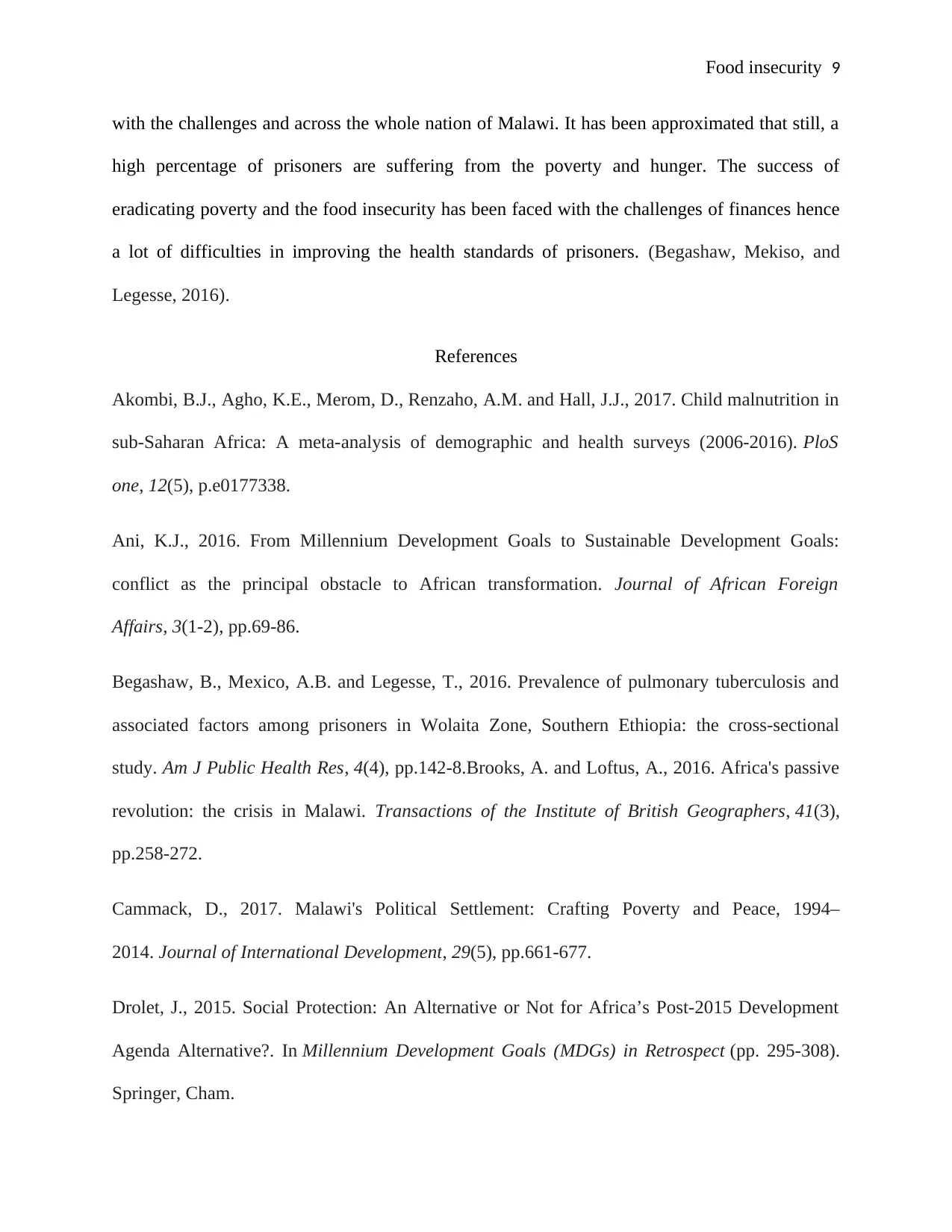
Food insecurity 9
with the challenges and across the whole nation of Malawi. It has been approximated that still, a
high percentage of prisoners are suffering from the poverty and hunger. The success of
eradicating poverty and the food insecurity has been faced with the challenges of finances hence
a lot of difficulties in improving the health standards of prisoners. (Begashaw, Mekiso, and
Legesse, 2016).
References
Akombi, B.J., Agho, K.E., Merom, D., Renzaho, A.M. and Hall, J.J., 2017. Child malnutrition in
sub-Saharan Africa: A meta-analysis of demographic and health surveys (2006-2016). PloS
one, 12(5), p.e0177338.
Ani, K.J., 2016. From Millennium Development Goals to Sustainable Development Goals:
conflict as the principal obstacle to African transformation. Journal of African Foreign
Affairs, 3(1-2), pp.69-86.
Begashaw, B., Mexico, A.B. and Legesse, T., 2016. Prevalence of pulmonary tuberculosis and
associated factors among prisoners in Wolaita Zone, Southern Ethiopia: the cross-sectional
study. Am J Public Health Res, 4(4), pp.142-8.Brooks, A. and Loftus, A., 2016. Africa's passive
revolution: the crisis in Malawi. Transactions of the Institute of British Geographers, 41(3),
pp.258-272.
Cammack, D., 2017. Malawi's Political Settlement: Crafting Poverty and Peace, 1994–
2014. Journal of International Development, 29(5), pp.661-677.
Drolet, J., 2015. Social Protection: An Alternative or Not for Africa’s Post-2015 Development
Agenda Alternative?. In Millennium Development Goals (MDGs) in Retrospect (pp. 295-308).
Springer, Cham.
with the challenges and across the whole nation of Malawi. It has been approximated that still, a
high percentage of prisoners are suffering from the poverty and hunger. The success of
eradicating poverty and the food insecurity has been faced with the challenges of finances hence
a lot of difficulties in improving the health standards of prisoners. (Begashaw, Mekiso, and
Legesse, 2016).
References
Akombi, B.J., Agho, K.E., Merom, D., Renzaho, A.M. and Hall, J.J., 2017. Child malnutrition in
sub-Saharan Africa: A meta-analysis of demographic and health surveys (2006-2016). PloS
one, 12(5), p.e0177338.
Ani, K.J., 2016. From Millennium Development Goals to Sustainable Development Goals:
conflict as the principal obstacle to African transformation. Journal of African Foreign
Affairs, 3(1-2), pp.69-86.
Begashaw, B., Mexico, A.B. and Legesse, T., 2016. Prevalence of pulmonary tuberculosis and
associated factors among prisoners in Wolaita Zone, Southern Ethiopia: the cross-sectional
study. Am J Public Health Res, 4(4), pp.142-8.Brooks, A. and Loftus, A., 2016. Africa's passive
revolution: the crisis in Malawi. Transactions of the Institute of British Geographers, 41(3),
pp.258-272.
Cammack, D., 2017. Malawi's Political Settlement: Crafting Poverty and Peace, 1994–
2014. Journal of International Development, 29(5), pp.661-677.
Drolet, J., 2015. Social Protection: An Alternative or Not for Africa’s Post-2015 Development
Agenda Alternative?. In Millennium Development Goals (MDGs) in Retrospect (pp. 295-308).
Springer, Cham.
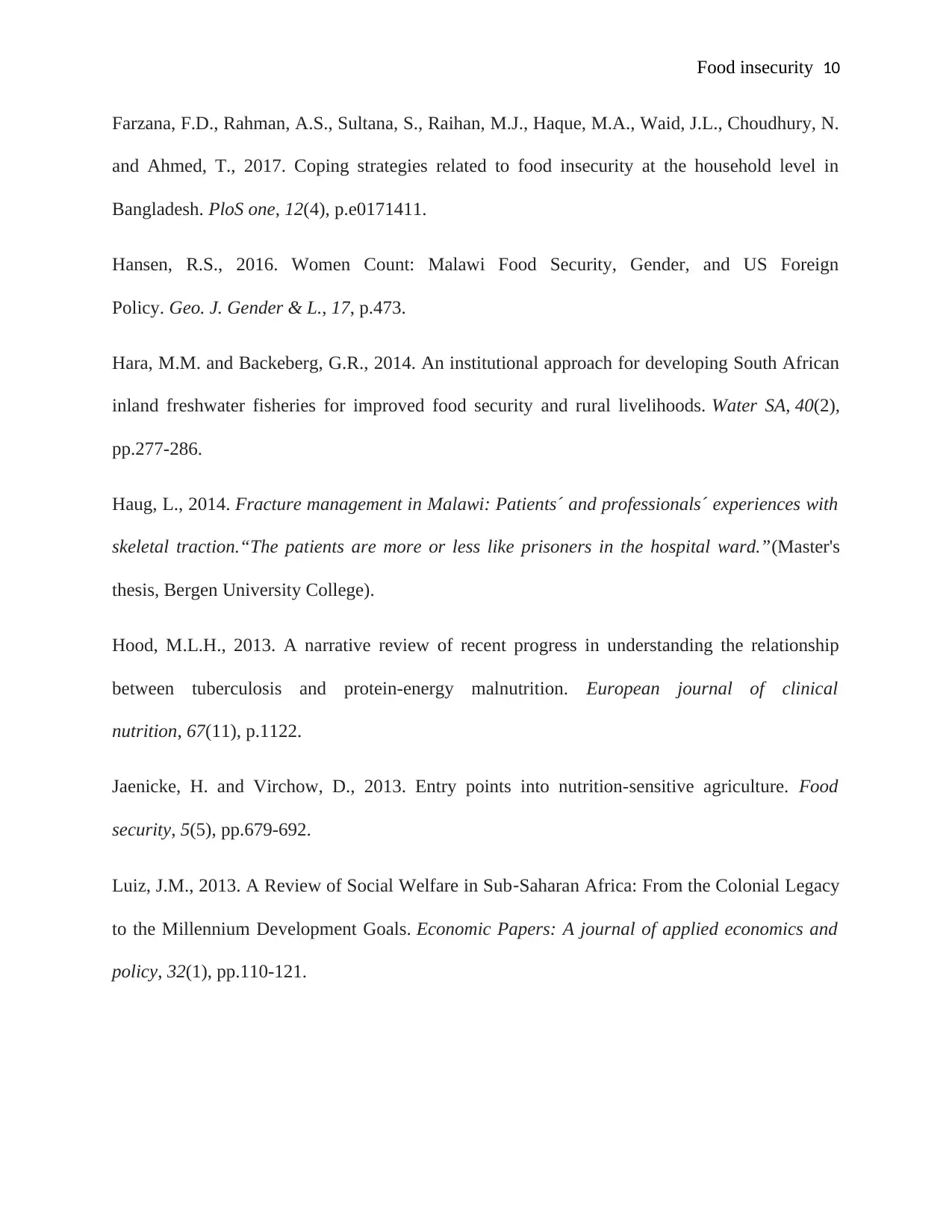
Food insecurity 10
Farzana, F.D., Rahman, A.S., Sultana, S., Raihan, M.J., Haque, M.A., Waid, J.L., Choudhury, N.
and Ahmed, T., 2017. Coping strategies related to food insecurity at the household level in
Bangladesh. PloS one, 12(4), p.e0171411.
Hansen, R.S., 2016. Women Count: Malawi Food Security, Gender, and US Foreign
Policy. Geo. J. Gender & L., 17, p.473.
Hara, M.M. and Backeberg, G.R., 2014. An institutional approach for developing South African
inland freshwater fisheries for improved food security and rural livelihoods. Water SA, 40(2),
pp.277-286.
Haug, L., 2014. Fracture management in Malawi: Patients´ and professionals´ experiences with
skeletal traction.“The patients are more or less like prisoners in the hospital ward.”(Master's
thesis, Bergen University College).
Hood, M.L.H., 2013. A narrative review of recent progress in understanding the relationship
between tuberculosis and protein-energy malnutrition. European journal of clinical
nutrition, 67(11), p.1122.
Jaenicke, H. and Virchow, D., 2013. Entry points into nutrition-sensitive agriculture. Food
security, 5(5), pp.679-692.
Luiz, J.M., 2013. A Review of Social Welfare in Sub‐Saharan Africa: From the Colonial Legacy
to the Millennium Development Goals. Economic Papers: A journal of applied economics and
policy, 32(1), pp.110-121.
Farzana, F.D., Rahman, A.S., Sultana, S., Raihan, M.J., Haque, M.A., Waid, J.L., Choudhury, N.
and Ahmed, T., 2017. Coping strategies related to food insecurity at the household level in
Bangladesh. PloS one, 12(4), p.e0171411.
Hansen, R.S., 2016. Women Count: Malawi Food Security, Gender, and US Foreign
Policy. Geo. J. Gender & L., 17, p.473.
Hara, M.M. and Backeberg, G.R., 2014. An institutional approach for developing South African
inland freshwater fisheries for improved food security and rural livelihoods. Water SA, 40(2),
pp.277-286.
Haug, L., 2014. Fracture management in Malawi: Patients´ and professionals´ experiences with
skeletal traction.“The patients are more or less like prisoners in the hospital ward.”(Master's
thesis, Bergen University College).
Hood, M.L.H., 2013. A narrative review of recent progress in understanding the relationship
between tuberculosis and protein-energy malnutrition. European journal of clinical
nutrition, 67(11), p.1122.
Jaenicke, H. and Virchow, D., 2013. Entry points into nutrition-sensitive agriculture. Food
security, 5(5), pp.679-692.
Luiz, J.M., 2013. A Review of Social Welfare in Sub‐Saharan Africa: From the Colonial Legacy
to the Millennium Development Goals. Economic Papers: A journal of applied economics and
policy, 32(1), pp.110-121.
Secure Best Marks with AI Grader
Need help grading? Try our AI Grader for instant feedback on your assignments.
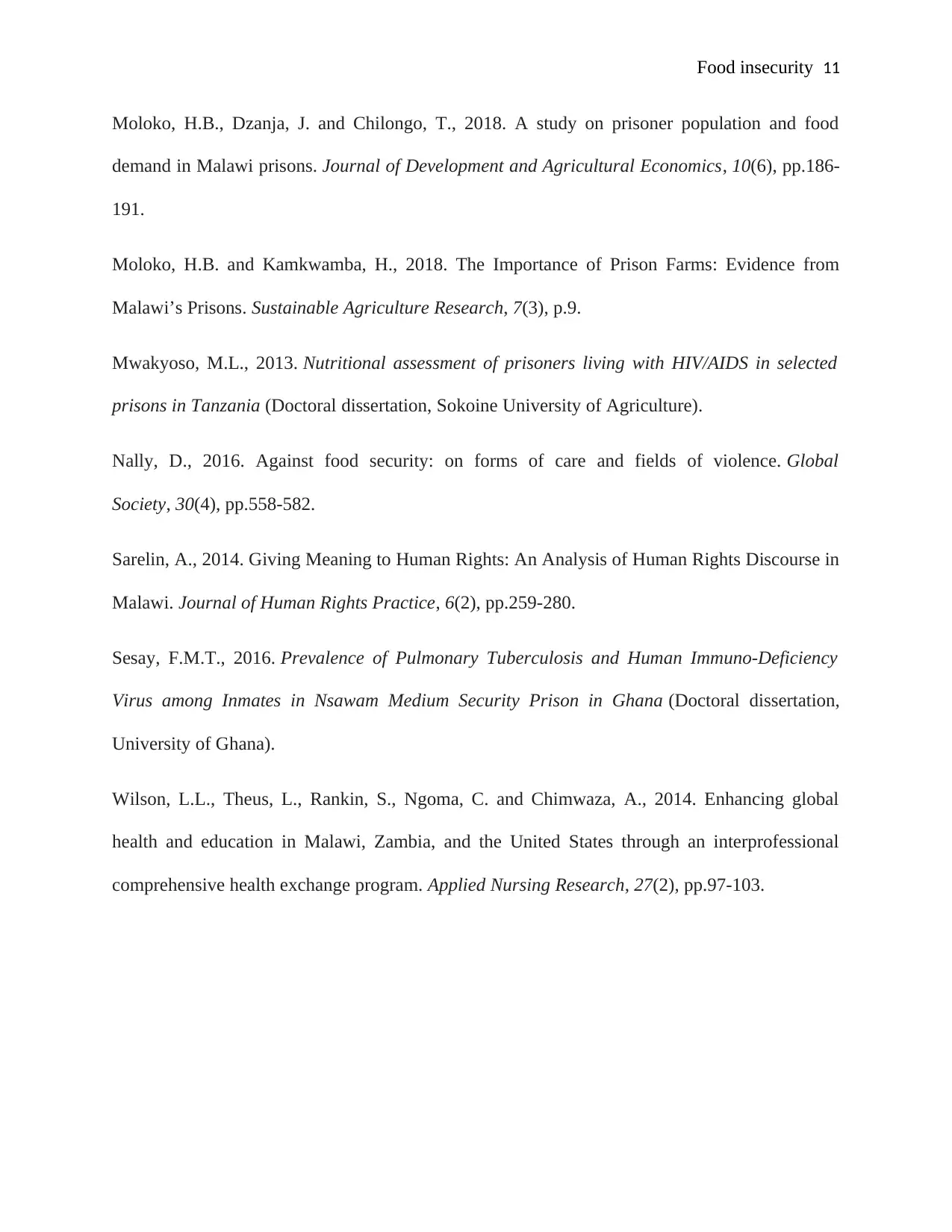
Food insecurity 11
Moloko, H.B., Dzanja, J. and Chilongo, T., 2018. A study on prisoner population and food
demand in Malawi prisons. Journal of Development and Agricultural Economics, 10(6), pp.186-
191.
Moloko, H.B. and Kamkwamba, H., 2018. The Importance of Prison Farms: Evidence from
Malawi’s Prisons. Sustainable Agriculture Research, 7(3), p.9.
Mwakyoso, M.L., 2013. Nutritional assessment of prisoners living with HIV/AIDS in selected
prisons in Tanzania (Doctoral dissertation, Sokoine University of Agriculture).
Nally, D., 2016. Against food security: on forms of care and fields of violence. Global
Society, 30(4), pp.558-582.
Sarelin, A., 2014. Giving Meaning to Human Rights: An Analysis of Human Rights Discourse in
Malawi. Journal of Human Rights Practice, 6(2), pp.259-280.
Sesay, F.M.T., 2016. Prevalence of Pulmonary Tuberculosis and Human Immuno-Deficiency
Virus among Inmates in Nsawam Medium Security Prison in Ghana (Doctoral dissertation,
University of Ghana).
Wilson, L.L., Theus, L., Rankin, S., Ngoma, C. and Chimwaza, A., 2014. Enhancing global
health and education in Malawi, Zambia, and the United States through an interprofessional
comprehensive health exchange program. Applied Nursing Research, 27(2), pp.97-103.
Moloko, H.B., Dzanja, J. and Chilongo, T., 2018. A study on prisoner population and food
demand in Malawi prisons. Journal of Development and Agricultural Economics, 10(6), pp.186-
191.
Moloko, H.B. and Kamkwamba, H., 2018. The Importance of Prison Farms: Evidence from
Malawi’s Prisons. Sustainable Agriculture Research, 7(3), p.9.
Mwakyoso, M.L., 2013. Nutritional assessment of prisoners living with HIV/AIDS in selected
prisons in Tanzania (Doctoral dissertation, Sokoine University of Agriculture).
Nally, D., 2016. Against food security: on forms of care and fields of violence. Global
Society, 30(4), pp.558-582.
Sarelin, A., 2014. Giving Meaning to Human Rights: An Analysis of Human Rights Discourse in
Malawi. Journal of Human Rights Practice, 6(2), pp.259-280.
Sesay, F.M.T., 2016. Prevalence of Pulmonary Tuberculosis and Human Immuno-Deficiency
Virus among Inmates in Nsawam Medium Security Prison in Ghana (Doctoral dissertation,
University of Ghana).
Wilson, L.L., Theus, L., Rankin, S., Ngoma, C. and Chimwaza, A., 2014. Enhancing global
health and education in Malawi, Zambia, and the United States through an interprofessional
comprehensive health exchange program. Applied Nursing Research, 27(2), pp.97-103.
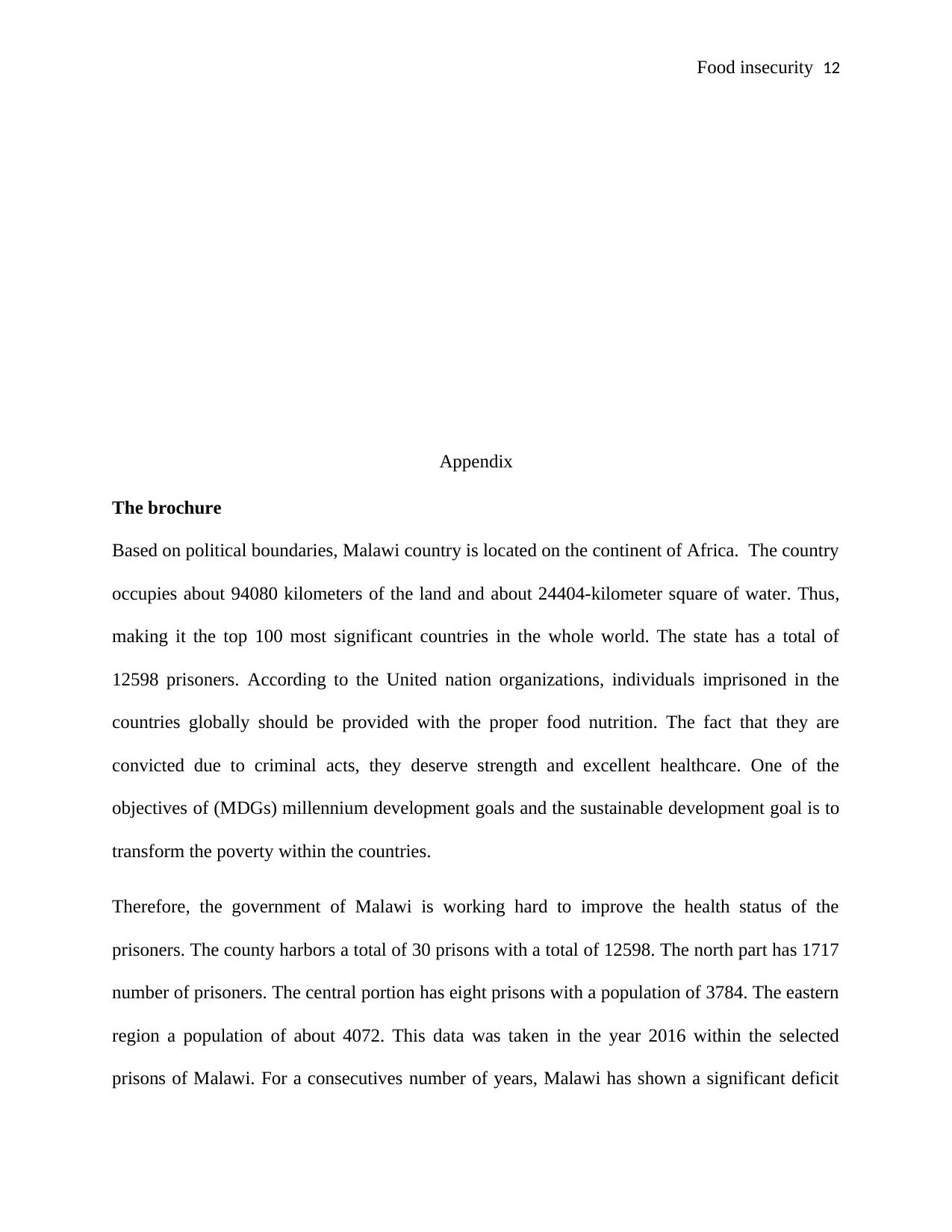
Food insecurity 12
Appendix
The brochure
Based on political boundaries, Malawi country is located on the continent of Africa. The country
occupies about 94080 kilometers of the land and about 24404-kilometer square of water. Thus,
making it the top 100 most significant countries in the whole world. The state has a total of
12598 prisoners. According to the United nation organizations, individuals imprisoned in the
countries globally should be provided with the proper food nutrition. The fact that they are
convicted due to criminal acts, they deserve strength and excellent healthcare. One of the
objectives of (MDGs) millennium development goals and the sustainable development goal is to
transform the poverty within the countries.
Therefore, the government of Malawi is working hard to improve the health status of the
prisoners. The county harbors a total of 30 prisons with a total of 12598. The north part has 1717
number of prisoners. The central portion has eight prisons with a population of 3784. The eastern
region a population of about 4072. This data was taken in the year 2016 within the selected
prisons of Malawi. For a consecutives number of years, Malawi has shown a significant deficit
Appendix
The brochure
Based on political boundaries, Malawi country is located on the continent of Africa. The country
occupies about 94080 kilometers of the land and about 24404-kilometer square of water. Thus,
making it the top 100 most significant countries in the whole world. The state has a total of
12598 prisoners. According to the United nation organizations, individuals imprisoned in the
countries globally should be provided with the proper food nutrition. The fact that they are
convicted due to criminal acts, they deserve strength and excellent healthcare. One of the
objectives of (MDGs) millennium development goals and the sustainable development goal is to
transform the poverty within the countries.
Therefore, the government of Malawi is working hard to improve the health status of the
prisoners. The county harbors a total of 30 prisons with a total of 12598. The north part has 1717
number of prisoners. The central portion has eight prisons with a population of 3784. The eastern
region a population of about 4072. This data was taken in the year 2016 within the selected
prisons of Malawi. For a consecutives number of years, Malawi has shown a significant deficit
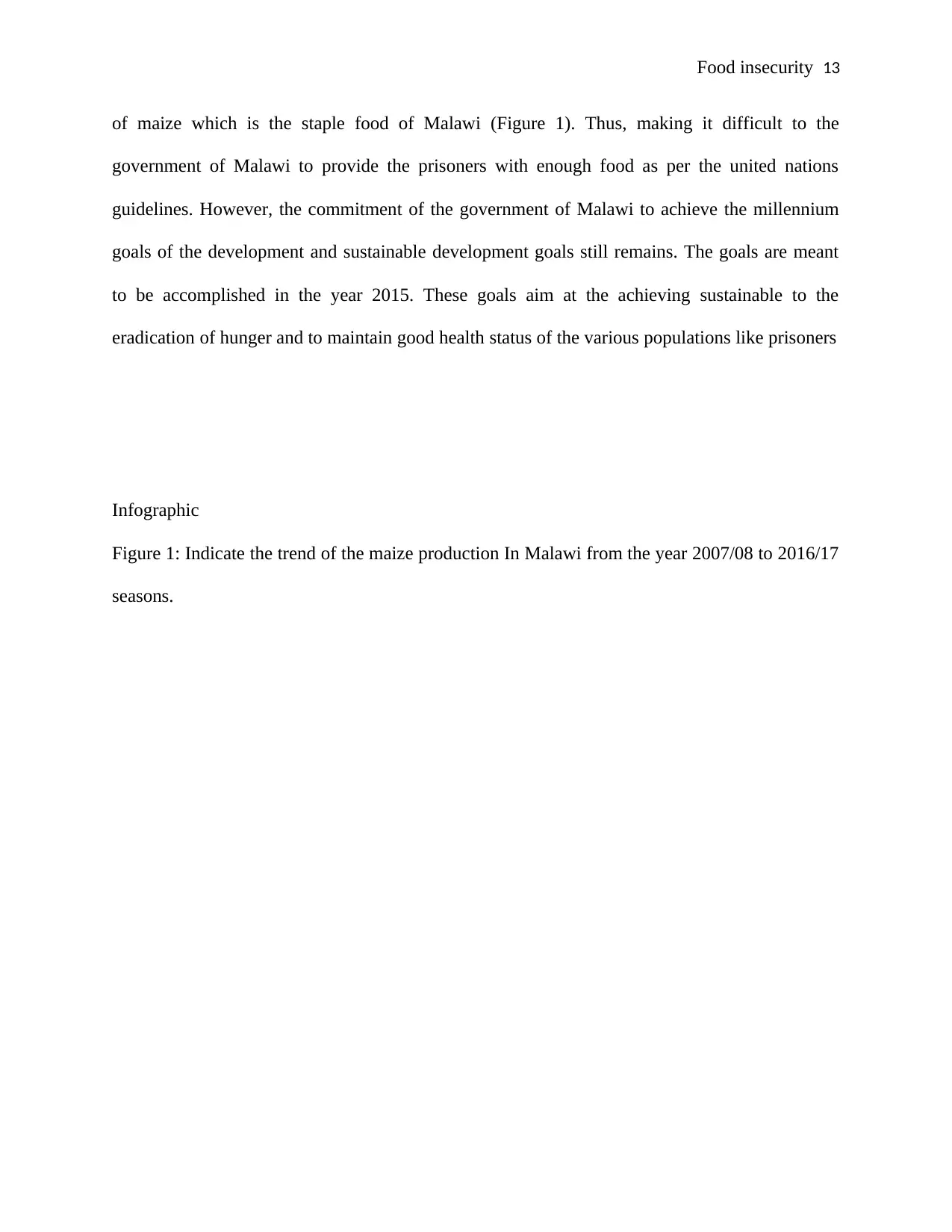
Food insecurity 13
of maize which is the staple food of Malawi (Figure 1). Thus, making it difficult to the
government of Malawi to provide the prisoners with enough food as per the united nations
guidelines. However, the commitment of the government of Malawi to achieve the millennium
goals of the development and sustainable development goals still remains. The goals are meant
to be accomplished in the year 2015. These goals aim at the achieving sustainable to the
eradication of hunger and to maintain good health status of the various populations like prisoners
Infographic
Figure 1: Indicate the trend of the maize production In Malawi from the year 2007/08 to 2016/17
seasons.
of maize which is the staple food of Malawi (Figure 1). Thus, making it difficult to the
government of Malawi to provide the prisoners with enough food as per the united nations
guidelines. However, the commitment of the government of Malawi to achieve the millennium
goals of the development and sustainable development goals still remains. The goals are meant
to be accomplished in the year 2015. These goals aim at the achieving sustainable to the
eradication of hunger and to maintain good health status of the various populations like prisoners
Infographic
Figure 1: Indicate the trend of the maize production In Malawi from the year 2007/08 to 2016/17
seasons.
Paraphrase This Document
Need a fresh take? Get an instant paraphrase of this document with our AI Paraphraser
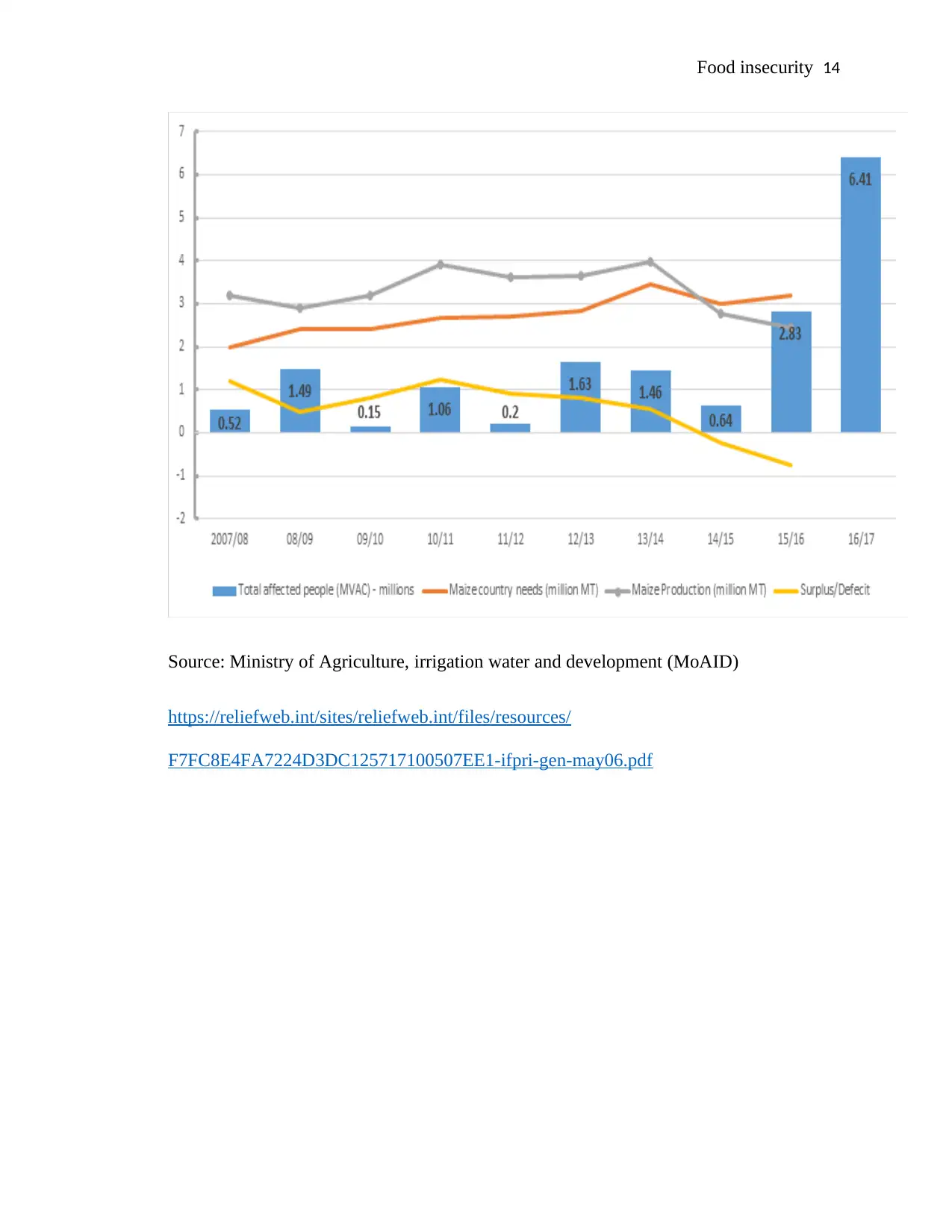
Food insecurity 14
Source: Ministry of Agriculture, irrigation water and development (MoAID)
https://reliefweb.int/sites/reliefweb.int/files/resources/
F7FC8E4FA7224D3DC125717100507EE1-ifpri-gen-may06.pdf
Source: Ministry of Agriculture, irrigation water and development (MoAID)
https://reliefweb.int/sites/reliefweb.int/files/resources/
F7FC8E4FA7224D3DC125717100507EE1-ifpri-gen-may06.pdf
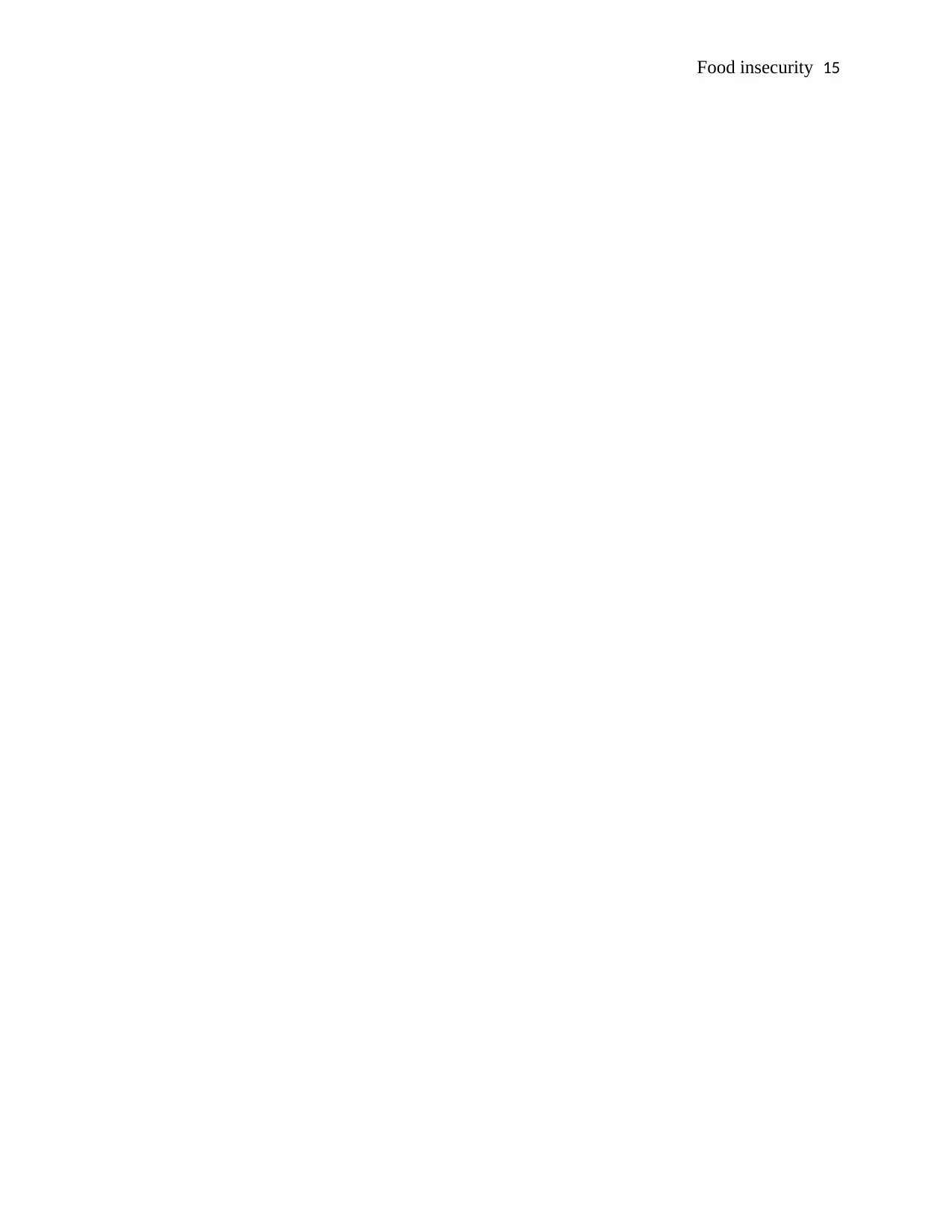
Food insecurity 15
1 out of 15
Your All-in-One AI-Powered Toolkit for Academic Success.
+13062052269
info@desklib.com
Available 24*7 on WhatsApp / Email
![[object Object]](/_next/static/media/star-bottom.7253800d.svg)
Unlock your academic potential
© 2024 | Zucol Services PVT LTD | All rights reserved.





